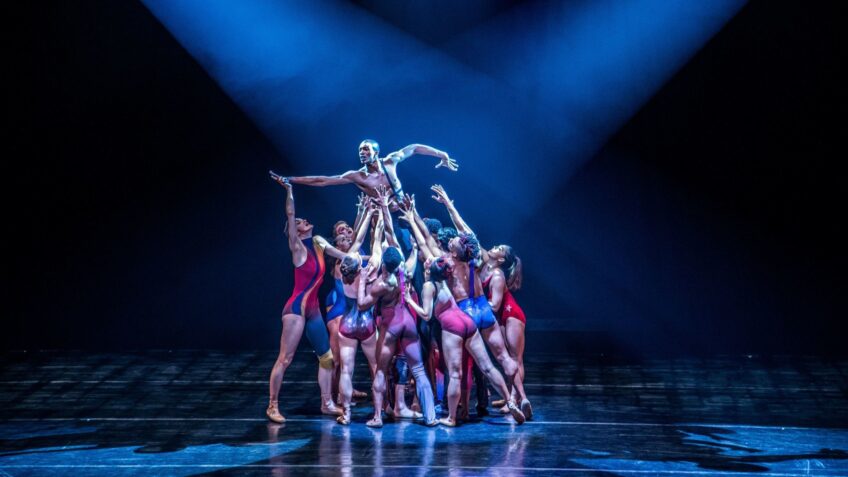 United States Complexions Contemporary Ballet: Dancers of Complexions Contemporary Ballet. Wallis Annenberg Center for the Performing Arts, Beverly Hills, 14.4.2022. (JRo)
United States Complexions Contemporary Ballet: Dancers of Complexions Contemporary Ballet. Wallis Annenberg Center for the Performing Arts, Beverly Hills, 14.4.2022. (JRo)

Snatched Back from the Edges
Choreography – Dwight Rhoden
Music – Martin Gore, Sanada Maitreya, Shirley Caesar, Terrell Lewis, Tye Tribbett,
Jon Batiste, Frederic Chopin, Aloe Blacc, Benjamin Clementine
Lighting – Michael Korsch
Costumes – Christine Darch
Sound – Corey Folta
StarDust
Choreography – Dwight Rhoden
Music – David Bowie
Lighting – Michael Korsch
Costumes – Christine Darch
Dancers: Jacopo Calvo, Serafin Castro, Jillian Davis, Vincenzo Di Primo, Thomas Dilley, Larissa Gerszke, Brandon Gray, Joe Gonzalez, Tatiana Melendez, Khayr Muhammad, Simon Plant, Zion Pradier, Miguel Solano, Tim Stickney, Eriko Sugimura, April Watson
To see Complexions Contemporary Ballet is to embrace the world. With a roster of dancers from all backgrounds and ethnicities, the company features both inclusivity and dancers with a formidable skill set. In the words of founders Dwight Rhoden and Desmond Richardson, the mission of Complexions is to ‘bring unity to the world one dance at a time’.
The company’s versatility is striking – they are adept across all dance forms from hip-hop to ballet, modern to classical. In an evening of Dwight Rhoden’s choreography, the dancers’ athleticism and technical prowess were on full display,
Snatched Back from the Edges was created at the height of the pandemic, and it comes laden with anxiety over the state of the world. The opening reflected a creeping dread that exploded into fear, helplessness and rage. Choreography for the upper body used moves such as extended arms with frantically fluttering fingers, thrusting arms that shrink back towards the torso, arms cradling heads and fists punching the air. The lower body displayed a ballet vocabulary complete with arabesques and pirouettes – the women en pointe and men partnering them in a semi-classical mode. While the company’s technique showed a mastery of the combination of idioms, the disconnect between the styles of upper and lower body grew oddly repetitive. I longed to see some inventive lower body movement in a contemporary vein beyond the predictable deep knee bends.
The music, a collection of tracks including electronic, gospel and jazz, had an overall heaviness that referred to the darkness of the subject matter. The handsome costumes by Christine Darch featured color-block leotards in somber colors.

StarDust, choreographed by Rhoden, paid tribute to David Bowie. Though the company clearly loved their romp through Bowie’s music, for me the tribute missed its mark. I suppose we all have different takeaways from Bowie’s work – mine is of a rock-singing performance artist grounded in the Minimalism of the 1970s, whose references ran the gamut from German Expressionism to commedia dell’arte to outer space. He was an artist whose costumes could be flamboyant but whose performing style was subtle. Rhoden left subtlety behind, giving his tribute to Bowie a glam rock vibe. The production felt like a 1970s Studio 54 fever dream complete with men ‘walking the runway’, vamping and strutting in six-inch platform boots, big hair, painted faces, bare chests and tights. Various male dancers traded the role of Bowie, standing at the front of the stage, lip-syncing his songs and wildly gesticulating. The effect was to distract from the dancers performing behind him who were engaged in Rhoden’s choreography.
In StarDust, the contemporary aspects of the choreography were more fully integrated between upper and lower body movement – there was a nice touch of turns on flat feet skimming the floor. In an effective reference to Bowie’s androgyny, one of the male dancers performed en pointe, reminding me of the dancers of Les Ballets Trockadero de Monte Carlo, affectionately known as the Trocks. (If you haven’t seen it, there’s a marvelous documentary about this singular troupe called Ballerina Boys.)
A cheap looking, garish curtain of metallic streamers formed an enormous backdrop, distracting even further from the dancing and giving the stage the aura of a high school gymnasium. Skillful lighting by Michael Korsch overcame some of the distractions by highlighting the dancers. The Darch costumes were a patchwork of styles attempting to capture the Bowie look.
A lighter touch might have improved the production, but for me Bowie was lost not found.
Jane Rosenberg
